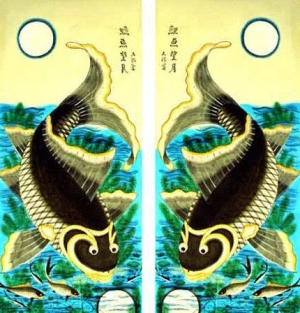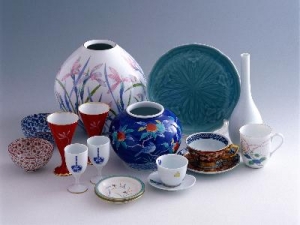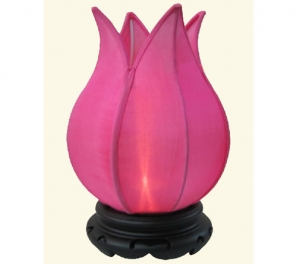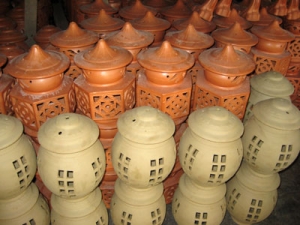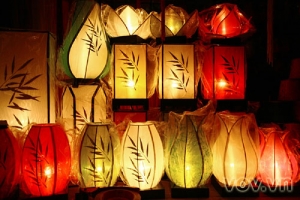
Asia Pacific Travel Team
Special feature of the Mekong Delta’s culture, Phung Hiep floating market
When going to Phung Hiep, visitors will see thousands of small boats with full of agricultural products from Western corners to form 1km long floating market. It's said to be a fruit-market of the Southern part and the market is special feature of the Mekong Delta’s culture.
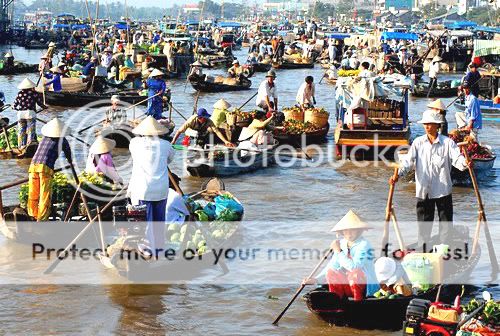
Phung Hiep floating market.
The market meets all day long, but it’s the noisiest and busiest in the morning. The precious evening, from far-and-wide, boats with full of seasonal vegetables and fruits such as mangoes, durians, bananas, oranges, coconuts, etc left their villages to wait for the sunrise market. Every boat is full of fruits. Some boats are covered with roofs, some are not. On boats without roofs, the sellers have to hold high a stick hanging with fruits as signals. Market-goers do not bargain, just a few words exchange, they sell and get paid. Normally, fruits are sold and brought to big boats. Then they will be transported to fruit-processing factories or to Ho Chi Minh City, Vung Tau, even to Hanoi and Northern provinces.

Fruits are hanged high to attract the buyers.
Although it's a floating market, services are available, foods and drinks on small boats twist and turn to serve hungry sellers and buyers. When someone wants to buy the products, they only need to whistle or wave band. Besides fruits, local products like snakes, birds, turtles, etc are easy to find near Phung Hiep bridge. These specialties are almost bought and brought to restaurants in Can Tho or Ho Chi Minh City.
The atmosphere in Phung Hiep market was exciting, as we witnessed snake traders fearfully transferring poisonous copperheads, kraits, and rattlesnakes, from their cages to purchaser’s jute bags.
The price of a snake ranges from tens of thousands of dong for individual specimens, to hundreds of thousands of dong per kilogram. One kilogram of water snakes is priced at VND30, 000-VND50, 000 (US$1.88 - $3.13); while copperheads are sold from VND50, 000-VND400, 000 ($3.13 - $25) per kilo.
Ranking the second after the snakes in quantity at Phung Hiep market is wild birds. All species favoured by urban gastronomers such as cao, cu dat, stork, blosh dove, moorcook, and la mia, are sold at the market.
Birds are hanged up on the motorbikes of bird hunters from rural areas and confined in narrowed cages. Thousands of birds are purchased each hour, and transported to “headquarters”, then retailed to restaurants in Ho Chi Minh City and southwestern provinces.
Phung Hiep Snake Market, located close to the floating market, is known worldwide. Visitors from all over the world go there to taste the snake liquor and see the dangerous snake dance.
Tien River Flower Market
On the way to the sea, Cuu Long River divides itself into nine branches; one is Co Chien branch flowing through Vinh Long province. It is the gift that nature rewards Long Ho land which have long cultural traditional. Near the river branch, every spring, there is a flower market which is one of the most beautiful flower markets in Cuu Long River Delta – Tien River flower market.
From about the middle of lunar December on, boats and canoes bustlingly reach the coast of Tien River. Flower growers from everywhere inside and outside the province gather here to sell their products. There are Vinh Long yellow apricot flower; Sa Dec daisy, rose; Cai Mon marigold, Can tho old ornamental plants …, hundreds of types of flowers competitively display their beauties.
The boats closely stand and contain a plenty of flowers, forming a floating market on the river. Flowers spread along the road from Vinh Long market to Cai Ca Bridge, Trung Nu Vuong, Hung Dao Vuong streets, Le Lai square…until the cultural centre of the province, creating a large field of brilliant colorful flowers.

Tien River flower market is not simply a trading place but a traditional activity. Without appointments, there is a chance for local people to meet together every year. Many from Tra Vinh evenly join the market just to buy a rose for their lovers. Some people from Can Tho or Ben Tre come to find an ideal branch of apricot tree for decorating inside their houses that likes a New Year wish. Many groups of old women and men, living in Vinh Long centre commune, visit the flower market every day to see, to choose that likes a reason for going to the market. It also can be considered an elegant interest.

In the cold weather of the days near Tet, wind from Tien River blows immensely, both people and flowers are bright. In this sacred moment, sky and land, people and flowers seem to mix together, creating a featured traditional beauty of Cuu Long River region.
Tay Do Night Market
Come to Tay Do night market, visitors will enjoy an interesting travel tour. The market likes a complex picture, really illustrating the daily life of residents in the downstream of famous Me Kong Delta.
About 1km far from the centre of Can Tho city to the west of Hau river, located in Can Tho International Trade Fair Centre, Tay Do market is not only the trading centre of Southern provinces but also attractive entertainment and tourism destination.
Although the Tay Do night market was just activated few years ago, it is considered a typical, special and fascinating cultural travel destination in Can Tho which attracts not only local people but also visitors from far. Formerly, Tay Do market is a wholesale market, exchanging products with many locales in and out of the country. Besides the task of product exchanging, there are cuisine and entertainment services there. Because of its large scale and importance to the local area, Tay Do market becomes a large trading centre of Southern provinces.

The architecture of Tay Do night market is harmonious with the landscape around and has the emphasized Southern style. The market is scientifically divided into stalls which are clear, neat, and aesthetical. Roads in the market are plasticized and clearly wide.
The products in Tay Do night market are very various, meeting the requirements of residents and tourists in selecting products. Besides trading activities, there are modern entertainment services in Tay Do night market such as: games, outside music shows and other programs.
Come to Tay Do night market, visitors will enjoy an interesting travel tour. The market likes a complex picture, really illustrating the daily life of residents in the downstream of famous Me Kong Delta.
Muong Hum Market
For people in ethnic groups in South West region, they go to the market not only for shopping. The market is also a place for young people to relax, date. People come to the market to see and to be seen.
From Lao Cai central commune, visitors must go 20km of asphalt road by car to Bat Xat district, then from there go 24km of pass way to reach Muong Hum market. Muong Hum market is located under the small valley, behind pure stream, rounded by extremely high mountains. It’s a weekend market near the spring that is a meeting, communicating, trading and playing place of people in the ethnic groups Ha Nhi, Mong, Hoa, Giay, Red Dao, Dao Tuyen, Han…
Just in several hours, the remote valley Muong Hum, Lao Cai, becomes a bustling place, the joining point of culture and cuisine of people in different ethnic groups.
Muong Hum market is opened in every Sunday from 7.00 am to 1.00 pm. Visitors can go from Lao Cao to Muong Hum by train with the ticket price 20,000 VND or by motorbike (xe om) which costs 70,000 VND.

From 7.00 am, people sit crowdedly in the bus from Lao Cai to Muong Hum. There is a plenty of women sitting shakily, swinging their legs on the packages which are fully piled in the walking path. After 3 hours going on car, there is a walking part across the valleys and passing the rocks.
People put their products in embroidered bags, hemp bags, sacks and baskets wearing on the shoulders. The pairs of slippers with so much mud stick to, the trousers that are rolled up several times show the hard way that they have passed.

In the market, many Thai girls wearing long pink, green shirts gather around the stall selling handmade silver jewelries. At other corner, there are orange and green dresses of H’mong girls crowdedly standing around the heap of pomegranate.
Right behind that, bamboo shoots are displayed in abundance on the banana leaves, and Ha Nhi healers explain the use of herbal drug powder that they have gathered from the forest. Go further in the market, there is a crowd of children eating pho (rice noodle), the noodle threads are still fresh because they have just been made some hours ago.
It’s very interesting that each time when the transaction is finished, money is taken out from ridiculous positions such as under the trousers, on the sleeves, the bags near the for-sale willet, or under the heap of dry beans. The market is full of people making transactions, bustling activities and colors.

If visiting a restaurant in Muong Hum, visitors will have a chance to enjoy horse meat fried with onion, pig entrails served with mint leaves and don’t forget to have them with Lao Cai wine or fresh beer.
For people in ethnic groups in South West region, they go to the market not only for shopping. The market is also a place for young people to relax, date. People come to the market to see and to be seen. The young Dao girls wear beautifully and sophisticatedly with red scarves on their heads which are rolled up and long to the ears.
The long black dresses of Ha Nhi ethnic group is embroidered with green patterns that is new and sophisticated. From a week before the market, H’mong women spent their whole day to string the plastic beads on monofilament threads and wind the jewelry around the head that looks like a crown.
When the market ends, people can see H’mong wives walking, taking the horses along to carry their drunken husbands to home; the children speaking English proficiently despites of never going to the language school…
Translated by Vu Thuy Duong
Luc Yen Gem Market
Gems as the products are displayed in groups on the table. Gems maybe have been operated or being original. However, no matter what kinds of gem, they all look brilliant.
Luc Yen gem market is opened at a beautiful corner of a lake in Yen The town. The market works in just several hours in every morning. Depending on reasons and weather, the market can be taken place sooner or later, but at about 6.30 am there are sellers in the market. They slowly arrange their stalls that are not complicated but very simple. The market contains about thirty to forty stalls; all sellers are female who almost has attached to the market since its establishment.

Luc Yen is the only destination in all over the country where there is gem picture making career. Visit the place, people can have a chance to discover the gem picture making career as well as to contemplate the specious pictures which cost hundreds of millions VND.
Gems as the products are displayed in groups on the table. Gems maybe have been operated or being original. However, no matter what kinds of gem, they all look brilliant. According to the sellers, gems are gathered from the persons who have already gone to the mountains; if have time, craftsmen will operate the gems to make pendants of rings, necklaces, earrings, etc… Gems are also used as materials for making gem picture, which are sold in the unit of kilogram or gram.

Each of blue, red, purple, yellow, white, black gems having different sizes and shapes is supervised and considered by the customers who are conversant with gem. The prices are announced depending on the type of gem which can be ten thousands, hundreds of thousand or a million, tens of millions dong. However, the succession of transaction is decided by the bargaining process.
Besides gem traders and makers seeking for materials, there are many people who have heard about the gem market then come to this to see and to buy some products as the souvenirs. After two to three hours, the market is closed. According to the sellers, in different days, there can be transaction costing tens, hundreds of millions dong or just several millions.
The owner of a gem stall in Luc Yen market said that every early morning, hundreds of local residents went to the forest, walking along the stream, picking up each gem. After a long time, the gem became rare so people had to go further to the caves to gather it. Nowadays, people find it hard to seek for gem in the cave; many of them must use machines to dig deeply on the mountains then wash the soil for gem.

If people find out original sapphire, ruby gems (which are big, transparent, right color, not cracked), they can sell them with the price of several hundred millions dong. However, they usually get the color gems including ruby, sapphire which have lower quality, being crushed and small, used for making picture. To get the suitable color gems (especially black gems for drawing hair, blue ones for illustrating the color of water), they must wander on the mountains in a month.
For directly seeing the gem exploiting fields, it takes about 30 minutes riding motorbike. Different from gold field, the gem fields locates scattered over the mountains and forests. The local residents freely exploit the gem, that’s why there is a gem market which is also the supplying source for the gem picture making career. The visitors also can pick up the gem themselves.
Folk Paintings
Folk paintings are a combination of traditional cultural values with ancient artistic methods that have been created through the labour of past generations. There are two types of Vietnamese folk paintings, Tet (Lunar New Year Festival) paintings and worshipping paintings.
The Vietnamese believe in ancestor worship and the deification of natural phenomena, both of which are reflected in the paintings.
Due to their historical popularity, the folk paintings were produced in large quantities. This high demand was met through the use of the woodblock carving printing technique, which has been practiced by the Vietnamese for many centuries. During the Ly Dynasty (12th century), there were many families who specialized in woodblock carving. By the end of the Tran Dynasty, they were also printing paper money. At the beginning of the Le So Dynasty, the Chinese technique of carving printing boards was adopted and improved. The History Museum and the Fine Art Museum in Hanoi still keep old printing boards as archives.
During the Mac Dynasty (16th century), folk paintings developed quite extensively and were popular among the aristocracy in Thang Long. In the 18th and 19th centuries, the art of folk painting was stable and highly developed.
Depending on artistic style, drawing-printing technique, and the materials used, folk paintings are classified into painting trends according to the name of their place of production.
Each style of painting is different. However, in all the styles, shapes are created based on the concept of don tuyen binh do (single line-simple designs), which uses lines to bend the coloured shapes and to make a border for the picture. Another method used is thuan tay hay mat (easy to draw and to see). With this design form, the folk paintings do not depend on the rules of perspective. The deities are large and take the upper positions, while the ordinary people are drawn on a smaller scale and the size of the animals and the natural scenery depicted depends on their relationship to the sentiment or story being expressed. These unique characteristics make the paintings profoundly impressive.
As a result of cultural exchange, Vietnamese folk paintings have retained and developed certain traditional aspects. As well, the paintings have been influenced and enriched by the genius of other painting styles. One exception is Dong Ho paintings, which continue to exist unchanged against the challenges of time.
The refined art of Bat Trang ceramics
Bat Trang is an ancient village situated on the northern bank of the Red-river, about eight kilometers from the center of Hanoi with seventy-two white ground hillocks and Chu Dau china of Hai Duong province.
As far back as 600 years the village has supplied ceramic bowls, cups, bottles, jars and tiles to the whole of Northern Vietnam. With precious soil, unique secret methods of making ceramic enamel and wonderful artistic depictions on the products, Bat Trang ceramics have become valuable goods that are highly appreciated by domestic and international communities and have been exported to places as far away as Indonesia, India, Japan, Turkey, Iraq and Egypt. Bat Trang bricks were also used to build the Forbidden City in Beijing and famous mosques in Egypt and the Middle East thanks to their creative carved images.
Bat Trang ceramic products of pearl; cracked and ash-colored enamel are the most sophisticated in the world and are now displayed in famous museums throughout the world, including Guimet (France), Brussels (Belgium), the Rijec museum (Holland), the national Museum of Australia, San Francisco (America) and Tokyo (Japan).
After rebuilding and developing the handicraft village, Bat Trang has become a large center for tourism and trade in Hanoi. Hundreds of domestic and foreign tourists visit Bat Trang daily to buy unique products made by the skillful craftsmen. When you come here, you are not only able to choose from a wide range of goods but you can also go for a sightseeing tour or try to make china products yourself under the supervision of one of the craftsmen. Furthermore, the area is renowned as a place of literature in Hanoi, with 346 people passing national examinations here and going on to become the highest-ranking officials of Vietnam in the feudal time. The village festival is held from the 15 to 22 February of lunar calendar (about March of the solar calendar), at the same time as the Gom market festival, one of the biggest market festivals of Vietnam.
Fan makers
Fans made of paper, silk, and wood are a cultural feature only found in Asia.The fans symbolize the grace and reserved character of women, and the elegance and strength of men. They are also means of showing love between couples and have played an important role in poetry, songs, plays and Vietnamese daily life for thousands of years.
Furthermore, these decorative products are now exported to Japan, Great Britain and France. Trang Son Village in Thach That district, Ha Tay province (30 kilometers from Hanoi to the North West), specializes in making some of the most famous fans for nearly one thousand years. When using Trang Son Village`s fans tourists are offered a unique opportunity to understand Vietnamese people`s culture, simple but profound.
The craftsmen of the village moved to Hanoi in the eighteenth century to form the famous Hang Quat street (fan makers and sellers) which sadly is no longer where these fans are made today.
Old-style Thanh Ha Ceramics
Located next to the ancient quarter of Hoi An, the Thanh Ha ceramic village has been in existence for a long time. The village is famous for its traditional ceramic products.
In the 1990s, the village was a different kind of place and plastic and aluminum products were the rule. During those years, ceramic making was not happening in the village. In recent years, the tourism in Hoi An has taken off, and some families in Thanh Ha village dug back into their history and brought traditional ceramics back to life. Besides making ceramic ware for the everyday needs of the common people, the villagers are also turning out souvenirs to sell to the tourists. They are doing well with children`s toys, lampshades, and indoor decorative items.
By the end of 2004, the craft was pretty much in full swing in Thanh Ha. The village began receiving orders from the new big hotels in Hoi An. However, to get a firm market position for the ceramic products, the local administration still has a few things to do.
In early 2005, the Industry Department of Quang Nam province carried out a pilot project to build a new-technology kiln that promises to consume less fuel and produce higher quality ceramics. The kiln is there but it sits idle because no one knows how to use it.
In the tourism development plan of Hoi An, Thanh Ha is mentioned as one of the places that needs investment in ecological tourism. Just because of its location next to the Hoi An ancient quarter, Thanh Ha has a better chance than some other traditional villages in Quang Nam province such as the Tra Que vegetable village, the Kim Bong carpentry village, and the Phuoc Kieu bronze casting village. However, visitors to Thanh Ha may be a bit disappointed when seeing the narrow range and unimaginative design of its ceramic products.
A member of Hoi An`s leadership, Nguyen Su, says, "We plan to invest in developing a number of craft villages surrounding Hoi An, including Thanh Ha. That is a very costly proposition. A happy fact is that the simple ceramics made by the Thanh Ha villagers are being bought by the tourists because of their honest and simple designs."
Nevertheless, it's true that Thanh Ha village`s ceramic products are made in the old way and cannot compete with the mass-producers in terms of commercial appeal, mass sales and uniformity. Their inability to obtain a proportionately higher price has a direct influence on the lives of the people.
"Each ceramic kiln in Thanh Ha village can hold two large boats of clay. And it takes more than 20 days to make finished ceramic products for which we can get just VND3-4 million. A gas-fired kiln of the same capacity in Bat Trang village can make products for which they can get tens of millions of dong or even VND100 million in just one week," Mr. Tuan says. One cannot compete commercially when making ceramics by old methods.
Hopefully, Quang Nam province, Hoi An and Thanh Ha will find a way to market the peculiar and valued ceramics of Thanh Ha village so that the potters can thrive and the craft can continue.
The Glowing Lanterns of Ancient Hoi An
The tradition to decorate the ancient town in Hoi An with multi-colored lanterns, which started three centuries ago, is still continued today on the fourteenth night of each lunar month in this small town in central Vietnam.
The history of the lanterns
In the past, Vietnamese people often put oil lamps in decorative spherical and hexagonal lantern shades, which were hung in the eaves and both sides of the door in the Chinese style. During the sixteenth and seventeenth centuries, Faifo (the name of Hoi An`s ancient town at that time) was bustling with foreign merchants from the Netherlands, India, and Japan around the clock. Japanese merchants often hung tube and canary-shaped lanterns along the poles in front of their houses, which lit up the whole commercial quarters at night with a glowing, mysterious light. Locals began hanging lanterns out as well, with hopes for bringing good luck and coziness to the town.
The decision to bring out the lanterns again in the autumn of 1998, however, was an unexpected success. Authorities of Hoi An`s ancient town chose the fourteenth night of each lunar month for a night of lantern festivities. On that night, most lights in houses and shops in the ancient town are turned off for the night and replaced with lanterns to light up their narrow streets and alleyways.
This year included a Vietnam-Japan cultural festival in Hoi An`s ancient town, where Japanese visitors showed off their famous art of paper lanterns. Local residents also had a chance to show their own multi-colored lanterns of many sizes made by experienced artisans, including large, unique lanterns made of rare woods with sophisticated designs and embellished with valuable works of art on each side. Those large, old-fashioned lanterns are now family treasures used only on the night of lanterns. Although lanterns are often lit up with ordinary light bulbs today, their soft light gives a hint of what romantic nights were like long ago.
Establishing a trademark for Hoi An`s lanterns
For many years, traditional colored lanterns have enchanted visitors to Hoi An, particularly foreign visitors. Every year, tens of thousands of Hoi An lanterns are exported or bought by foreign visitors as souvenirs and gifts. As a cultural and tourist product, the lanterns have helped raise incomes of Hoi An`s residents.
Hoping to cash in on the lanterns, several other areas have recently started to turn out so-called Hoi An lanterns. The low quality of these imitations, however, has harmed the reputation of traditional Hoi An lanterns, which has led long-time lantern makers to encourage local authorities to develop a specific trademark for Hoi An lanterns to preserve the beauty of the town`s long-lasting lanterns.
Nguyen Su, chairman of the Hoi An Town People`s Council and deputy party secretary, says the People`s Council has presented a resolution on developing the Hoi An lantern trademark, while the Quang Nam Province People`s Committee was asked to register collective protection of a Hoi An lantern trademark.
In the immediate future, the Hoi An Town People`s Committee named the Planning and Investment Department as project coordinator and developer. All lantern makers in the area can register for collective Hoi An lantern trademark protection, provided their products meet the required quality standards. Products meeting these standards can carry the words Hoi An and the emblem of the Cau Pagoda. Only then will lanterns be sold to the customers or be exported to other countries, which will establish a better reputation for Hoi An lanterns abroad.
Hoi An ancient town now has many shops selling a variety of lanterns, which are often red, yellow, or green depending on the surrounding fabric. Prices range from several ten to hundreds of thousands of Vietnamese dong depending on the size, colors, and quality of the surrounding fabric. Tang Ngoc Thu, owner of the Ngoc Thu Lantern Workshop, says, "Our products are sold at a wide range of prices to fit the budget of all customers. Our goal is to increase the popularity of Hoi An lanterns among domestic and foreign visitors."
Presently, Ngoc Thu is one of several enterprises producing lanterns with metal frames for both indoor and outdoor decoration, which have been exported to France, Germany, the US, and Australia. The products have also been showcased in fairs and exhibitions in Da Nang, Hue, and other domestic locations. Last year, a Hollywood studio placed an order with Ngoc Thu for 300 big lanterns to use in scenes in its films. The lanterns have also been written about in foreign journals.
Hoi An lanterns carry distinctive cultural values of the town that can help present one of Vietnam`s cultural heritage sites, Hoi An ancient town, to the outside world, while high-quality will ensure a better standard of living for residents.


